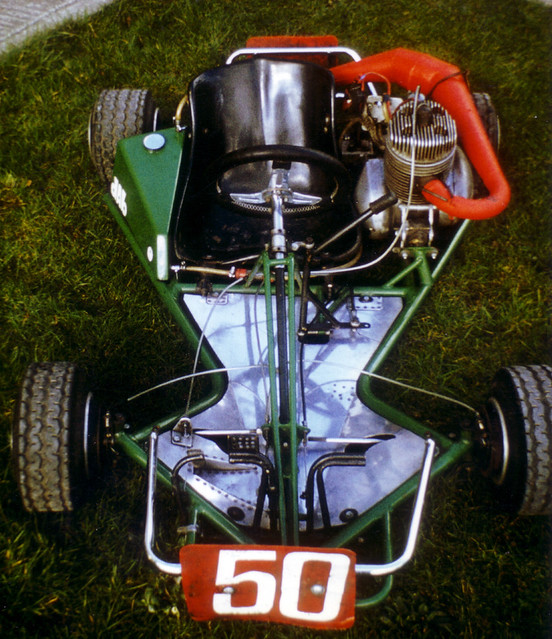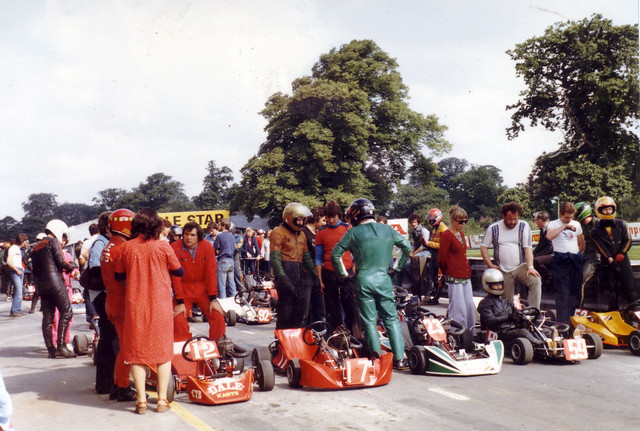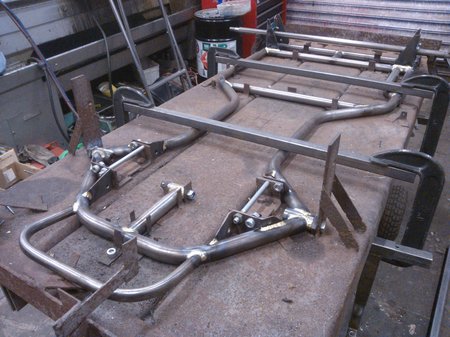The Kuga Kart
I started karting in the mid seventies, shortly after getting married. I had previously had brief forays into Autocross and Autotests, and was looking for a cheap form of competitive motor sport to have a go at before a family came along. I thought about karts…
I had been to see karting at the Long Marston circuit near Tring in the early 60s. Stirling Moss had appeared in a Keele kart with a Bultaco engine. Even back then the “go” had been dropped from the sport’s name…but still the unknowing public insists on adding that prefix!
So I went to a meeting at Little Rissington and see how it had changed. It was raining heavily. I thought the 210 National gearbox class might suit me, so I watched carefully. One bloke was half a lap ahead of all the others. He seems good, I thought, and looked in the programme....No. 44, Dale Falcon Villiers, driven by Nigel Mansell.
Over the winter I scoured Karting Magazine for a suitable machine. A 250- International at bargain basement price caught my eye…a Zip Silverstone with Merlin Rotary Valve engine. A bit of research revealed that Chris Merlin had concocted this engine and won the British Championship with it a few years earlier. It was a Villiers 9E with a square barrel like a Greeves Griffon, and a special right hand crankshaft half housing a disc valve like the 100cc karts had: a design going back to MZ 2 stroke racing bikes, I think. It had Tillotson carbs, the sort that have a diaphragm to pump the fuel using crankcase pressure pulses, and were used on chainsaws because they work upside down. This particular engine had had the Villiers 4 speed box replaced by an Albion 5 speeder, and had competed in the Snetterton 9 hour race on at least one occasion. By then, however, it was no longer a really competitive machine, despite being capable of around 120mph. Suzuki twins were the thing to have that year.
Although out of date and a bit tatty, my Zip Merlin offered a pretty hairy introduction to karting for a novice like me. Off I went to Shenington, where Eric Mansell (father of The Famous One) was scrutineer. Strangely, he tested everything by standing on the front bumper and observing what wobbled. Most mysterious.
Anyway, I did my 4 novice races, always starting at the back of the grid as the rules dictated for novices. And so I came to my first race on my 250 as a novice no more. Yellow number plates instead of black ones. Grid positions for the heats were by ballot...and I drew pole position! Only having previously experienced tail end grid positioning, here I was on the front row amid the old hands. Despite my tenseness, I got away quite well, only for the race to be stopped because a fair proportion of the field had crashed into the straw bales on the first corner, behind me.
After the St John ambulance men had done some enthusiastic bandaging, the race was restarted, with me on pole again. This time I stalled. I waved my arms in the air furiously while the field screamed past. When the 2 stroke haze had dispersed, revealing my stationary condition, a chap in yellowy gold leathers, who had been spectating while waiting for his 210 national race, ran out into the track to assist. Yes, it was NIGE!
He pushed me and the Zip Merlin. I was anxious to get going and dropped the clutch too early. Mansell nearly went A over T. "Let the bloody thing get rolling!" he shouted at me.
After a few races I realised it would make more sense to run in the 210 National class, so a suitable engine with Upton aluminium barrel was purchased and bolted to the Zip instead of the Merlin. I have a programme that proves that I competed in the same race as Mansell in 210N, but I must admit I don’t recall giving him too much to worry about…
By now the Zip was getting very tired. It had a few battle scars when I got it, and I had already added some more. By this time 99% of karts at any meeting were factory built, but I had a noticed that a chap called Paul Klaassen raced a kart called a Crusader at Shenington, which appeared to be a one off. This prompted me into thinking I would have a go at designing and building a kart of my own. I bought one of those sets of plans that Dale Karts sold to make your own Falcon like Mansell’s, but I just used them to copy the king pin geometry. The rest of the chassis’s design philosophy was based on the idea that no tube would have more than one bend in it, so it couldn’t be made on the wrong place! Reynolds 531 tubing was purchased from Dale karts, and bent for me by a certain George Brown in Linslade. (I wondered whether this could have been the George Brown of Super Nero motor cycle fame, but later research suggests it was not).
I now had a partner in this venture. This was my friend Keith Newman, who like me, was a Pressed Steel Fisher (later British Leyland) student apprentice at Cowley. Keith did his HND in Mechanical Engineering a year behind me at Oxford Polytechnic. One of his classmates was Adrian Reynard, who built his first Formula Ford car as his college project, with Keith’s assistance. When we started the kart project, we went to see Adrian at his original tiny, Sabre Automotive premises. He expressed some interest in helping, if we were to set out on a production venture, and said we should come back and see him when we were a bit further on. So after all the bending, filing and jig manufacture had been done, we went to find him to see about welding the pieces together. He was away, though, but one of his fabricators talked to us and offered to complete the work at his cottage. We took him up on this, and were glad we did, because the man was an absolute artist. We now had, not a pile of tubes, but DAB kart chassis 001 with absolutely immaculate nickel bronze welded joints. The welder’s name is lost to me in the mists of time, but I would love to know what he went on to do…
Progress was disrupted at this point, when I moved to Lancashire to take a job in the design office of Leyland Truck and Bus. The DAB 001 was completed for the 1977 season, however, and I competed with very limited success at Morecambe, Longridge, Rowrah, Fulbeck and Oulton Park. Problems were mainly to do with the engine or the driver, but the kart tended to understeer badly into the corners, then snap to oversteer on the exit. At the time I thought this was because the chassis was too stiff, but in retrospect I’m sure it was because I refused to replace the Continental slicks I had on the front until they were worn out. They never did wear out: they might as well have been made of wood…the level of grip would have been similar. I did always seem to go better in the wet, which I always put down to my natural skill rather than the fact that I had a decent set of hand cut wet tyres!
DAB 001

While I was contemplating with what I might have done better with my kart design, a new chap arrived at the Leyland Truck and Bus design office in the form of David Little. We soon got talking, since he had been a leading light in the very active Kart Club at Loughborough University. He had raced more successfully than me, with both Blow and Barlotti 210N karts. Rowrah was the track most local to his home, and here he had had numerous wins and given the late David Leslie a run for his money on several occasions.
David Little was now racing a Zip Mirage in 201N, but was keen to be involved with my latest design ideas. DBL Racing Developments was born to build not one, but a whole series of karts! (DBL = Davids Beard & Little). DL was content to let me have free rein on the design front, so long as we had a more glamorous and marketable name for the product than “DAB” (my initials). Hence the name Kuga emerged, long before Ford adopted it for their silly 4 x 4!
The design philosophy for the Kuga was as follows:
1. The chassis was to be torsionally as flexible as possible, but with a stiff rear end.
I don’t quite recall the reasoning behind these criteria at the time. To achieve them we had a very narrow wasted section in the chassis, and two cross members under the rear axle with a centre bearing. In retrospect, the centre bearing may have been a bad idea in terms of power loss…
We actually drew out the Zip Mirage, and put both it and the Kuga shape through an early Finite Element structural analysis program to see if we had got what we wanted.
2. Ease of manufacture was to be a consideration.
Where as the DAB001 had only one bend per tube, we got more adventurous here and had several. However, we thought things would be simpler if the bends were always in one plane. i.e the main members were flat and not sloping upwards towards the king pin. This decision had a major effect on the design of the front end
3. The front end geometry was to be multi-adjustable
I suppose the major advantage of this was that if we hadn’t got it right we would be able to change it. Anyway, the Kuga front end was the most significant part of the design. We had an aluminium upright into which the stub axle was bolted. A heavy duty RBJ series rose joint connected the bottom of the upright to the chassis, and took the main loadings. A smaller rose joint connected the top of the upright to the chassis via a small wishbone. Moving the wishbone backwards and forwards using different spacers altered the castor angle. The top and bottom rose joints could be adjusted to change the camber. The track could be altered by changing the length of the bush which fitted into the chassis and into which the bottom rose joint was screwed. There were different mounting points for the wishbone to go along with this. The brakes were of the floating disc, single position variety. AP Lockheed’s competition department were very helpful and supplied some special cylinders for us which were the small half of their racing motor cycle calliper with the cross feed passage blocked off. This bolted to the aluminium upright. The disc and the hub were from Brian Appleby, and were as used by Barlotti at the time.
4. Not to look like a clone of any other kart…
I think we achieved this alright!
Other Kuga features were an idler sprocket in the chain drive to the back axle which could be moved to adjust the tension. This avoided the need to lever the engine along slotted plates, which I always found a bit of a pain on other karts. An AP Lockheed standard motor cycle competition brake calliper was employed outboard at the rear, and we had a screw adjustable balance bar to adjust front to rear brake balance.
The Kuga 1 build
On a trip down south I went and found the Barlotti factory in Reading and bought T45 tubing for the main chassis members from Jack Barlow. I couldn’t locate the George Brown who had bent the DAB001 tubes, but I found a firm round the corner in Leighton Buzzard to do the job, who I think made roll over bars. They may have had something to do with SAH, the people who supplied Triumph car tuning parts at the time.
We constructed a humungous jig, with three scrap Leyland truck chassis members welded together to form the base. Then much filing and sawing commenced (it’s hard work with T45) in my garage and at the garage associated with Stokes Hall, the now demolished student residence associated with Leyland Truck and Bus. Although we had procured some welding kit, we were unsure that we could match the welding on DAB001 by the now inaccessible Reynard man, and looked for a local equivalent. We found a bloke called Ernie down the road who was confident he could do the same. We gave him the job, but we were hugely disappointed with the lack of elegance in the result. David L had to tidy up all the welds and in the process convinced us we should do it all ourselves in future.
The aluminium front uprights were initially machined from solid by my cousin at Titan Motorsports. He made a lovely job, but when we had plates welded to them to form the steering arms we were a bit nervous about their integrity. These items were thus replaced with cast ones produced at very reasonable cost, including pattern making and machining, by a supplier to Leyland Truck and Bus who we were very fortunate to be able to utilise. These new items were helicoiled for safety and had the steering arms incorporated. A small plate just had to be screwed onto them to run in wide track configuration. The castings were a bit on the heavy side though, and as we ran the Kuga we progressively filed more off the corners to make them lighter.
Kuga 001

The Kuga Races
We completed the Kuga in early 1980 and took it up to Rowrah for its maiden run. On the way we took a diversion to Heysham Head circuit near Morecambe where we showed it off to an intrigued Kelvin Hesketh. (Bert Hesketh and his son Kelvin used to have a workshop next the circuit where they built Star karts).
The run at Rowrah quickly hit a snag when the gear lever broke. We tracked down Terry Edgar (1977 100 International British Champion) in the village, and he repaired it for us. We got back to the track and ran with no more snags than I can recall, other than discovering that the brakes were rather powerful.
Our first race meeting, I think, was when David L drove the Kuga at Donington Park. I think he went reasonably well, but was still finding the over effective brakes a little difficult. Subsequently we reduced the mechanical advantage of the brake pedal, which improved matters, but they could perhaps still have benefited from detuning further to give better feel.
The Kuga went on to race at Cadwell Park, Oulton Park, Morecambe, and 3 Sisters. David was getting quite near the front of the field at times, and there were never any significant problems with the chassis. It worked especially well in the wide track configuration.
On the grid at Oulton: No. 17, here with Zip nose fairing.

Kuga 2
There was always the intention to build two Kugas. Work wasn’t too far behind on the second, but then David L got himself a new job in Scotland, and I was finding things more difficult in more ways than one now that I had two baby daughters. Tubes were bent and filed for the chassis, all the parts for the front end, the brakes and all the rose joints were bought, but that’s as far as it got. Then I moved house, and all the bits wre stowed away in the roof of the garage. The jig was progressively buried beneath all the stuff that naturally accumulates behind a garage…
30 years later
I came across the Karting Legends club stand at the Oulton Park Gold Cup 2010. I got talking to someone about the old days and left my contact details. Several weeks later I was contacted by Nick Purdie. The parts and jig were all unearthed and taken away by Nick. We hope to see Kuga 2 on the track after all, but now as a Historic Kart!
Right...next yarn, please!
Edited by David Beard, 07 September 2011 - 19:13.






















